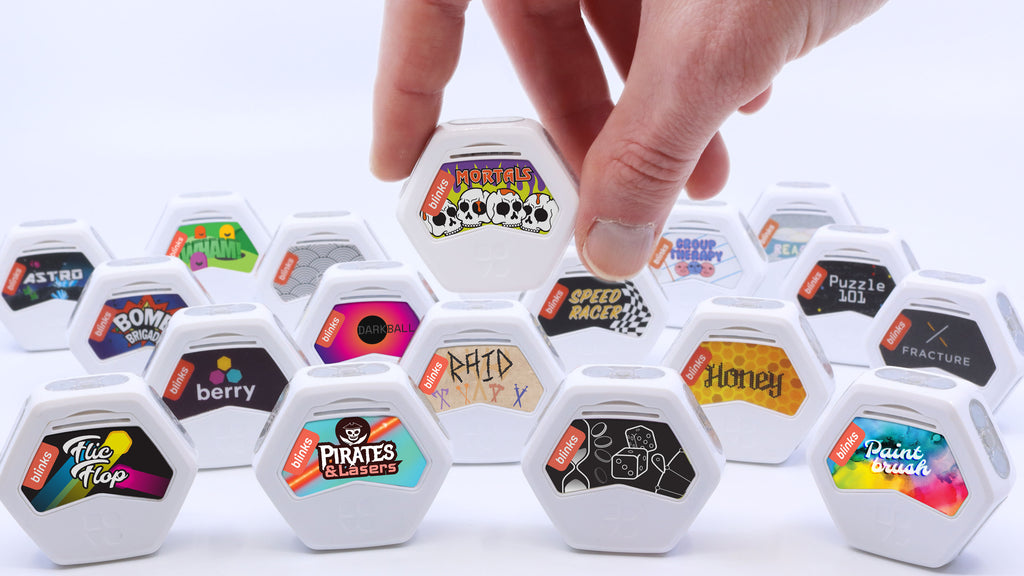Hi There,
It's Dan. Move38's Games Lead. Many people on our Kickstarter are asking "How have Blinks Games evolved over time."
To answer this question, we actually need to look at the origins of Blinks themselves. As many of you might know, Blinks, then called Automatiles, were created at the MIT Media Lab by Jon Bobrow, and the intention was to use them to simulate natural systems. It wasn’t until Game Design professor Celia Pierce and fellow lab mate, Em Lazer-Walker, saw them in motion that the notion of games on the platform even existed. This early work made the following statement about what a Blinks game is.
Winter 2016 - Blinks games are about strategic rearrangement.
The clearest use of a magnetic, tesselating game system is, of course, rearranging them. Their game, Fracture, is an incredible example or streamlined gameplay, and fits the platform perfectly. Another early game on the platform, BeRrY, would extend this idea to both rearrangement and simple state changes. But the next crop of games would make a different statement about what a Blinks game could be.
Winter 2018 - Blinks games are real-time

Mortals, another very early game for Blinks, took advantage of the fact that the platform can track time and interactions on its own, without the need for external timers. This inspired several other games, like Speed Racer and Bomb Brigade, which do away with traditional turn-based mechanics in favor of frantic, real-time decision making.
And for a time, these two types of games represented the entire library. Later, around the time that myself and a group of game design interns joined the team, a new definition of Blinks games emerged:
Summer 2018 - Blinks games are alive

It started with WHAM, a collaborative effort between all the interns in the summer of 2018. We set out to make a game where it was the human vs the machine, and the machine was capable of surprising and confusing its opponent. Puzzle 101, though very different in terms of gameplay, was another game where we set out to make the “smart” in “smart tabletop” much more present. The Blinks are more than just the pieces of a puzzle - they are the creators of the puzzle itself. Honey, a much later game, pushes this idea as far as it can go, and creates a living ecosystem out of Blinks. You don’t even have to actively play Honey, you can just set it up and let it play itself. Oddly, this idea brings everything full circle - after all, when Jon invented Blinks he was trying to mimic natural systems. But this wasn’t the only new idea that broke through at this time. We also took a cue from Speed Racer, and pushed Blinks games in a new direction, namely:
Fall 2018 - Blinks games are kinetic

This is where you get things like Flic-Flop and Astro - games where the form-factor of Blinks, and the fact that they are light and fun to hold, is front and center. Flic-Flop uses the smooth design and magnetic connection to create a dexterity game. Astro takes advantage of their small size to build a frantic, twister-like game experience. But the last type of game to be included in the launch were… a little different. And they had something fairly radical to say about what a Blinks game could be.
Spring 2019 - Blinks games don’t have to be games

This is where, I’ll be honest, I got a little spooked. When we were finalizing the list of games for launch, Jon had Zen Flow and Widgets, to experiments we had created, on the list. My initial thought was that no, we can’t release titles on a game platform that aren’t “games.” You can see the evidence of my hesitation in the existence of Takeaway Dice, Flip Bet, and Spinomino: three games I created within the Widgets game to help it make sense to me. But Jon was quickly proven right, because our early backers loved Zen Flow, a Blinks game that is really just an experience. To this day when I’m showing Blinks to new people, I install Zen Flow first to let them experiment, and it’s always a hit.
And that brings us to the present. The Blinks team has created 14 games that each have a slightly different perspective on what makes a game a Blinks game. So when we set out to create the Community Expansion, we wanted to find games that broke new ground, and had new takes on gameplay and the Blinks experience.
In my next update, we will dive deep into how we curated the Blinks Community Set and the unique ways that this batch of games brings new ideas to the System.
Until next time, Dan

